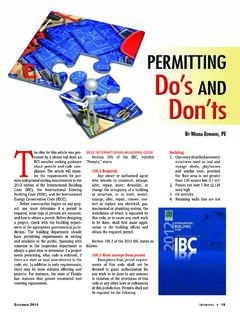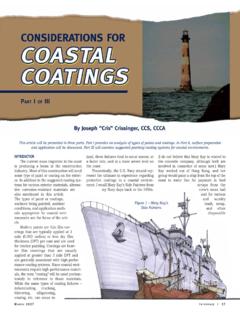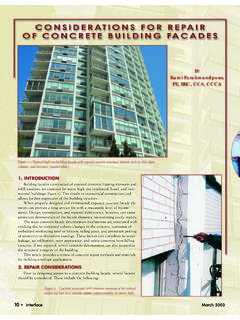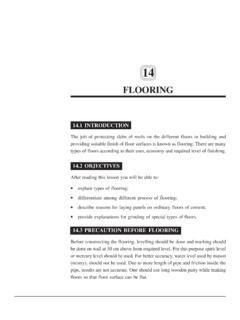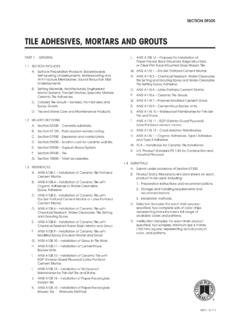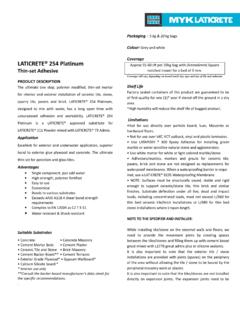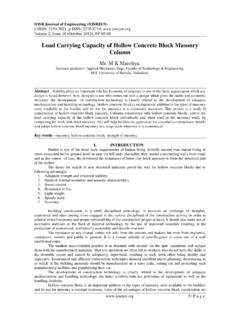Transcription of Roof Decks, A to Z Part 3: Structural Clay Tile and Plywood
1 This is the third in a series of articles briefly examining various deck types. Among the numerous considerations when selecting a roof system, the type of decking is among the most important. With the variety of decks to be encountered (both new and old), it is incumbent upon roofing experts to be the authorities on these matters. This article will explore features of 1) Structural clay tile and 2) Plywood . Structural CLAY TILE Structural clay tile was used extensively throughout the United States when cities were rebuilt following disastrous fires that occurred in the late 1800s. During that era, concrete production was in its infancy and did not even exist in some areas; steel was the dominant type of con struction, and Structural clay tile was the primary material used for fire proofing buildings, including floor and roof decks. Book tile is a form of Structural clay tile that was popular during the late 1800s and early 1900s.
2 The name is descriptive of the tile unit itself, which has the general appearance of a closed book, as shown in Figure 1. Book tile units were manufactured with concave and convex edges so that they would interlock when laid into position. This shape allowed units to abut one another. A common book tile unit dimension was 3 in thick by 12 in wide, supplied in lengths varying from 11 to 24 in. This thickness weighs approximately 18 pounds per sq ft. The term tile, as it relates to structur al clay tile roof decks, is often paired with descriptors such as 1) hollow, 2) building, and 3) book, in generic reference to the material. These modular units first gained favor for use in both Structural walls and non-load-bearing partitions due to their fairly low cost, ease of installation, and favorable performance during fire exposure. The units were laid in bedding mortar (sim ilar to their next-of-kin, brick masonry units) with head and bed joints struck full of mortar.
3 They could also be formed from the underside and integrated into cast-in place concrete on concrete structures Figure 2 Structural clay tile units integrated into cast-in-place concrete on a concrete structure. Figure 1 With the general appearance of a closed book, these units were popular during the late 1800s and early 1900s. NOVEMBER 2011 INTERFACE 5 Figure 4 The common arrangement of tiles nested onto sloped steel framing. Additional mortar would be struck into joints from the roof (top) side. Figure 3 Clay tile units mortared into place as fire-safing over Structural steel in an old attic. (Figure 2). Most multistory buildings of decades past having this type of roof deck might also have this arrangement as the floor-to-floor construction. The manufacturing process for struc tural clay tile typically involved extrusion through a die with individual units cut off at prescribed lengths and then fired in a kiln.
4 In the attics of buildings constructed in the early 1900s, these units were used widely on sloped planes as the roof deck and elsewhere on exposed Structural steel as fire safing (Figure 3). Book tile units were used for both steep and flat roof decks and were supported on inverted steel tees as shown in Figure 4. Space between the unit ends and the tee stems was filled with mortar. Tiles were sit-Figure 5 Tile covering on clay tile deck on a vintage pitched roof. uated over steel purlins spaced over rafters, joists, and trusses. The spaced purlin scheme allowed for quick and easy installa tion of a deck that was fireproof, and con structing it was not dependent on weather. Structural clay tile units were simply nest ed within the modules established by the tees, with fastening limited to bedding mor tar as the pieces were set with additional mortar struck into the joints from the roof side in order to key the individual pieces together.
5 The top and bottom surfaces of tiles usually had a rough texture so that a mortar-topping slab could be bonded on the top and a plaster finish adhered to the bot tom side, if desired. On some vintage buildings with pitched roofs, Structural clay tile was con sidered an accept-Figure 6 Tiles cast into the inboard face of a parapet. 6 INTERFACE able substrate for slate, copper, or roofing tile (Figure 5). Other variations could be Structural tiles and a concrete slurry top ping with integrated wood nailers or battens across the roof plane to which slates or tile would be anchored. These same vintage structures might also have tiles cast into the inboard face of parapets (Figure 6). On some lower slope assemblies, the Structural tile was used as substrate for a nailable concrete slurry. The green top ping was satisfactory during the original construction in terms of direct nailing; how ever, that same slurry topping today, after 60 or more years of service, will most likely not be accepting of nailing attempts.
6 Con sequently, attachment of the roof compo nents will need to be carefully reviewed. Possibilities may include a concealed batten arrangement to the steel framing or a NOVEMBER 2011 Figure 7 Attachment of new Plywood cladding using toggle bolts. Figure 8 Delamination and spalling of mortar topping course. through-bolted batten system to the tiles. Trial installation of anchors should be performed to determine feasibility of the proposed attachment method to minimize spalling. Low-slope clay tile decks are best suited for adhered or ballasted membrane systems. Mechanical fastening is generally discouraged because drilling and attachment may generate spalls and cracking of the tile. On pitched framing, reroofing can be carried out by attaching wood sheathing over the existing deck using toggle bolts (Figure 7) fitted NOVEMBER 2011 INTERFACE 7 with stress plates. Low-rise foam adhesive can also be used to embellish this secure ment, but dust and any other parting agent would need to be removed for proper bond ing.
7 Structural clay tile decks are suscepti ble to deterioration as well as corrosion of the embedded steel components. Failure of the tees can cause cracking in the tile units, which can allow leakage and further deteri oration of the steel components. There is also potential for cracking of the top shell of the units if care is not exercised during removal and installation of the roof system. Less serious but equally important issues are delamination and spalling of the mortar topping from the top surface of tile units (Figure 8). Hammer-sounding the sur face or removing a test square before pro ceeding with full-scale tear-off is a prudent step. Plywood Plywood apparently has several fathers. We are told that the modern version of ply wood was invented circa 1850 by Emmanuel Nobel (father of Alfred Nobel, the famous inventor of dynamite and founder of the Nobel Prize).
8 He apparently recognized Figure 9 Crickets/saddles can be crafted with Plywood to effectively divert water. Figure 10 Permanent distortion from insufficient fastening along edges, likely aggravated by substandard attic ventilation. that several thinner layers of wood bonded together would be stronger that one single, thick layer of wood; he is credited as well with invent ing the lathe used in Plywood production. Mean while, the APA (previously the American Plywood Asso ciation, but now the Engineered Wood Asso ci a tion) markets a publication entitled The Plywood Age, first published in 1955 to commemorate the first 50 years of the date near the dawn of the 20th century. industry. This would suggest a beginning Elsewhere, we find that Plywood was 8 INTERFACE NOVEMBER 2011 invented during World War II, where it was primarily used to build PT boats and land ing craft for the military.
9 Only after the war did residential construction begin to use this product. Yet a Google search reveals that it was the Egyptians, around 3500 BC, who first thought of sticking several thinner layers of wood together to make one thick layer. In any event, Plywood is perhaps the purest example of a nailable roof deck. It shares this attribute with oriented strand board (OSB), which has enjoyed great pop ularity over the past two decades as a sub stitute for Plywood . But OSB is different enough to be considered in a separate arti cle in this series. Meanwhile, although enjoying most of the residential roof deck market, Plywood is certainly not limited to that domain. Indeed, western states widely use this substrate for low-slope assemblies, as it is compatible with virtually any type of roof covering. Even crickets/saddles can be crafted with Plywood sheathing to effective ly divert water (Figure 9).
10 Wood products respond to variations in temperature and moisture content by changes in dimension. If no gap is provided between sheets, heat buildup will expand the Plywood . Edges cannot go down because of the framing members; they can not expand laterally because of neighboring sheets; consequently, the only path for expansion is upward. This often results in permanent thermal distortion (Figure 10), manifested as deck buckling (Figure 11). Aside from attachment deviations, poor attic ventilation is the single greatest cause of surface undulations. With sufficient plenum/attic ventilation and correct span/thickness relationships, virtually all undulations can be avoided. Formed metal H-clips (also called panel edge clips) should be used in most instances of Plywood deck construction (Figure 12). Contrary to widely held beliefs, these clips are not intended to be the spac ing element between panels, although they provide that incidental function.
